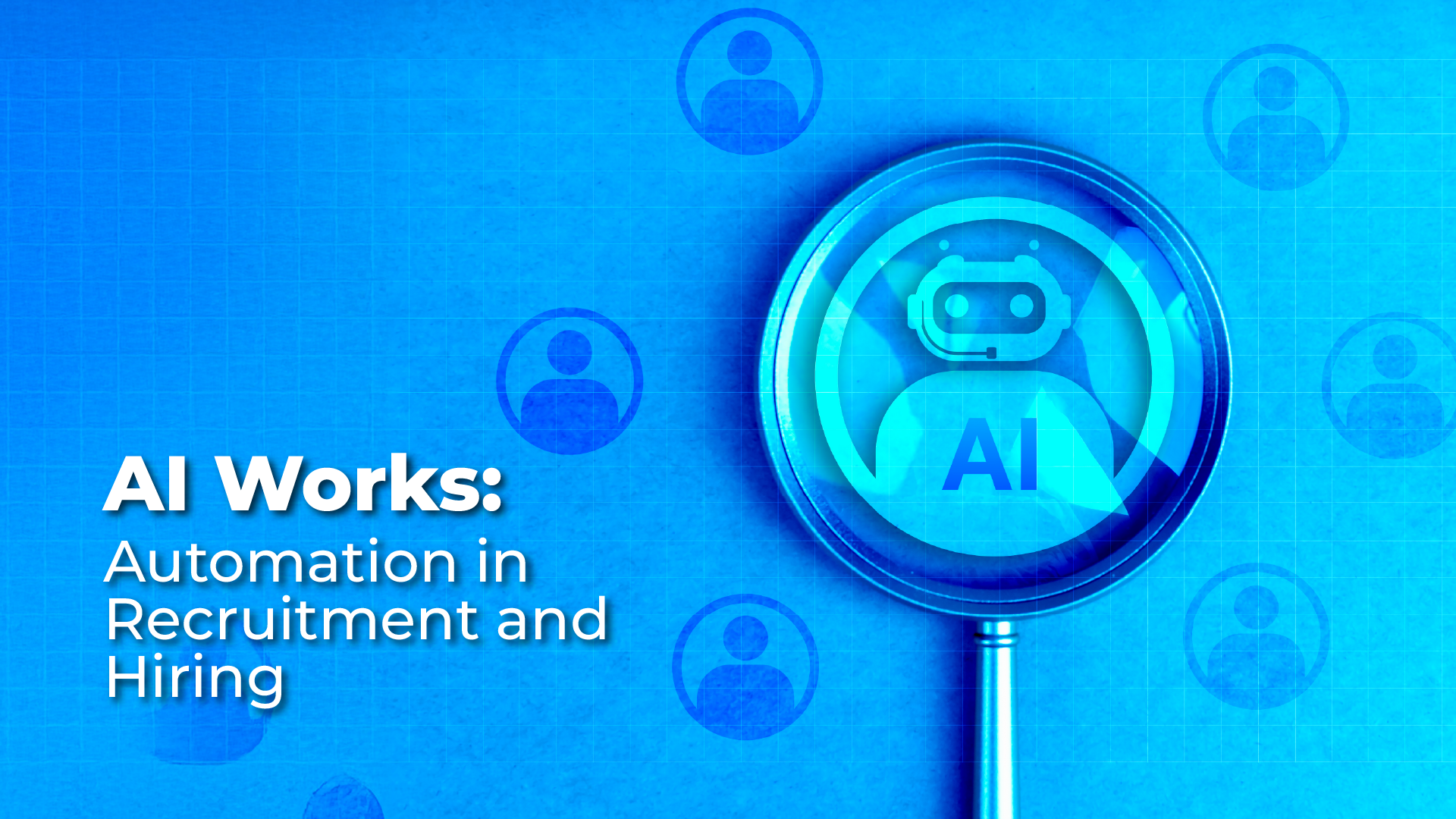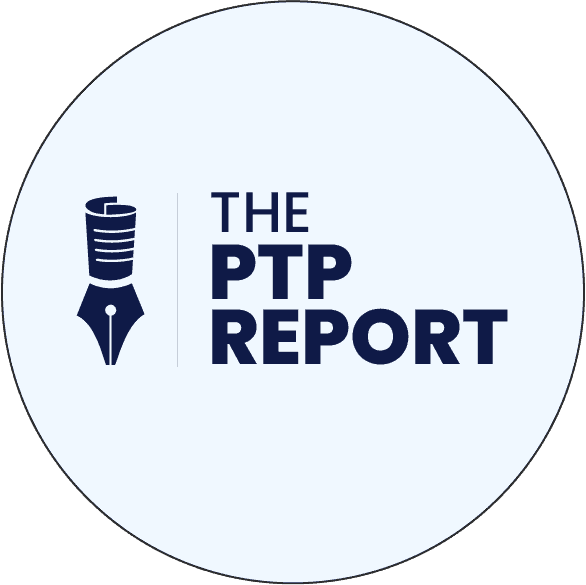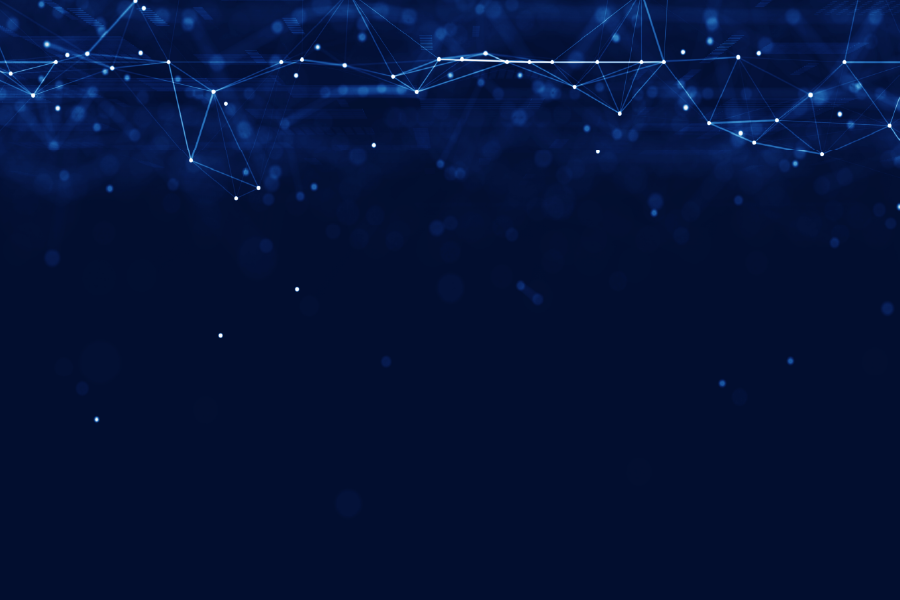Applying for positions continues to get easier. At least at the outset. For candidates, expedited forms, saved resumes, and AI-assisted cover letters can make it even easier than a copy-paste-edit before clicking submit.
Of course, the same is true for bots, and all combined, companies today often get overwhelmed by a staggering number of applications.
McKinsey received more than a million in 2024. Google more than three million. And per the World Economic Forum, the Indian government received 220+ million applications for central government positions between 2014 and 2022.
To deal with such a load, HR departments and staffing firms have been active with AI adoption, with 93% of Fortune 500 CHROs reporting they’re already using it in some capacity, per Gallup data.
These are often solutions that do initial submission screening, resume filtering, and candidate ranking. They work off the text they’re given, seeking to match criteria (such as keywords) for positions.
And while these systems help cut down the numbers, they can be prone to false negatives.
They’re also rapidly becoming obsolete.
Today, in the second of our AI Works series profiling AI adoption across industries, we look at AI use in recruiting.
We profile innovations that conduct initial interviews, provide far better (and more diverse) candidate lists, cut hiring time by two-thirds or more, even conduct technical screenings, write job descriptions, track skill gaps, and complete onboarding.
With nearly 80% of recruiters polled by Tidio saying they believe humans won’t be needed at all in the hiring process in the near future, we look at how close this is to becoming a reality.
Changes in the Use of AI in Recruitment
While companies are being buried in applications, candidates often feel like they’re pitching their resumes into black holes.
The automation of the job application process can at times be dehumanizing, and in addition to using AI systems for resume screenings (83% of companies per the Harvard Business Review), many companies also report using AI to scan for AI-generated copy in letters and resumes, per Gartner (69% in 2023).
And half of these companies indicate they move resumes and letters deemed to be crafted by AI into a separate process, or even de-prioritize them entirely.
But there is another way. Increasingly, companies are experimenting with alternatives to using AI to primarily screen provided materials. Conversational AI solutions, which can directly reach out and contact candidates themselves, are being applied in ways that (ironically) humanize the process, by engaging applicants and ultimately getting better results.
Research from Stanford and USC (by Emil Palikot, Ali Ansari, Ada Aka, and Nima Yazdani) compared these two approaches with randomized samples of applicants: Using automation to rank provided materials (with recruiters choosing the top for interviews), vs an AI-led interview process to assesses both technical and soft skills as a first stage. In both cases, top candidates were then passed on to humans to complete the process.
Those who underwent initial AI interviews were far more likely to be deemed viable candidates, and the amount (53.1% success rate for initial AI-interviews vs 28.6% for screened resumes) was striking. By completing a more fluid and responsive evaluation instead of filtering initially on keywords and provided text produced far more suitable candidates.
But the study went even further than this. When the transcripts of AI-led interviews and human recruiter interviews were blindly reviewed (based on question quality and conversational dynamics), the AI systems also did better than the human beings, with a greater consistency in what was also deemed a fairer process.
Also of note: it benefited younger candidates with less experience more than the other approach, with female candidates seeing modest improvements as well.
New Recruitment Technology in Play
As reported by Marlo Lyons in the Harvard Business Review, systems like Workday, Oracle HCM, and Greenhouse are in wide use, automating the search process for candidates among internal and external sources, evaluating and ranking them for a match. Tools like HireVue, VidRecruiter, CodeSignal, and Brazen are examples in use for AI pre-screening with written and/or video questions.
Fountain and Workday are examples of solutions introducing agents into their offerings, to further automate tasks that include outreach and even the proactive sourcing of candidates, with Fountain claiming it can automate the entire hiring process, providing feedback on every candidate.
Several companies have shared their own, proprietary successes.
Chipotle’s AI system Ava Cado (in collaboration with Paradox) led in their largest-ever spring recruitment drive this year (aiming for 20,000 seasonal employees), with striking results. In addition to bolstering the application completion rate to 85% from 50%, they’ve seen the time from application to work start drop to just four days from a prior average of 12.
This process sees applicants having a conversation with the AI “virtual team member” Ava, who also greets visitors to their site.
Bernard Marr has profiled AI use at the multinational consumer goods company Unilever. Like the examples we led with, they deal with a huge volume, processing more than 1.8 million job applications a year in an effort to recruit 30,000 individuals.
In collaboration with Pymetrics, they’ve developed a system that utilizes online games to test an applicant’s logic and reasoning as well as willingness to embrace risk. The results from these are matched to those of successful employees using machine learning techniques.
Those advancing to the next stage participate in AI interviews using natural language processing (NLP) and body language evaluation, and all told, this has cut some 70,000 hours of human interview and assessments time out of the process.
And in addition to time savings and quality improvements, each and every applicant now gets personalized feedback through the system.
The Automated Hiring Process: Uses Across the Funnel
So here we’ve picked and chosen a few well-promoted examples, but AI automation is increasingly being applied throughout the hiring process, in areas including the following:
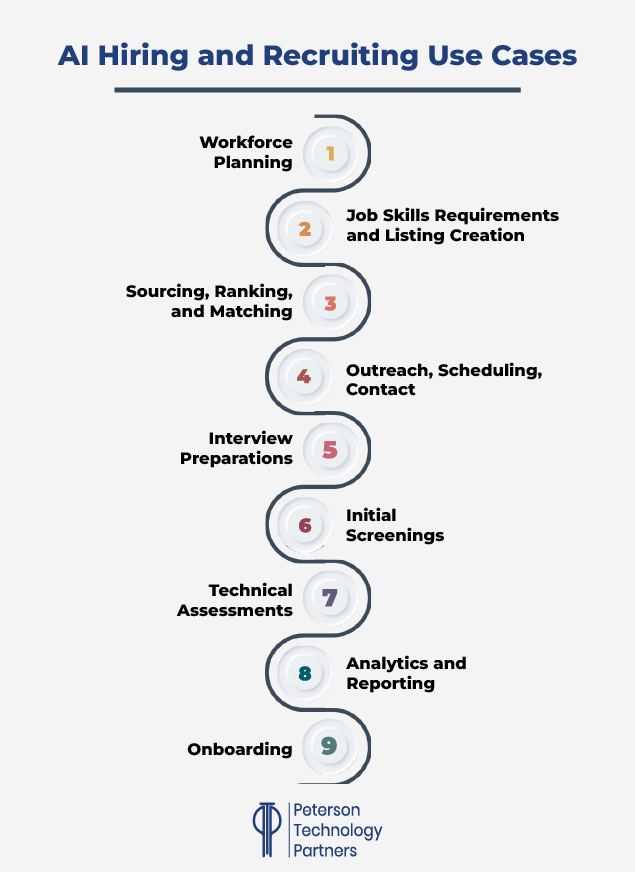
Increasingly AI is being used in hiring to provide benefits to companies and candidates alike, radically improving time-to-hire, cutting hours off recruiter days for repetitive tasks like dialing, scheduling, and conducting routine fact-finding, giving applicants clearer updates on status and more feedback on results, and ultimately producing better fits.
The hope is that these improvements will translate into better cultural fits, greater engagement, and thus stronger retention rates.
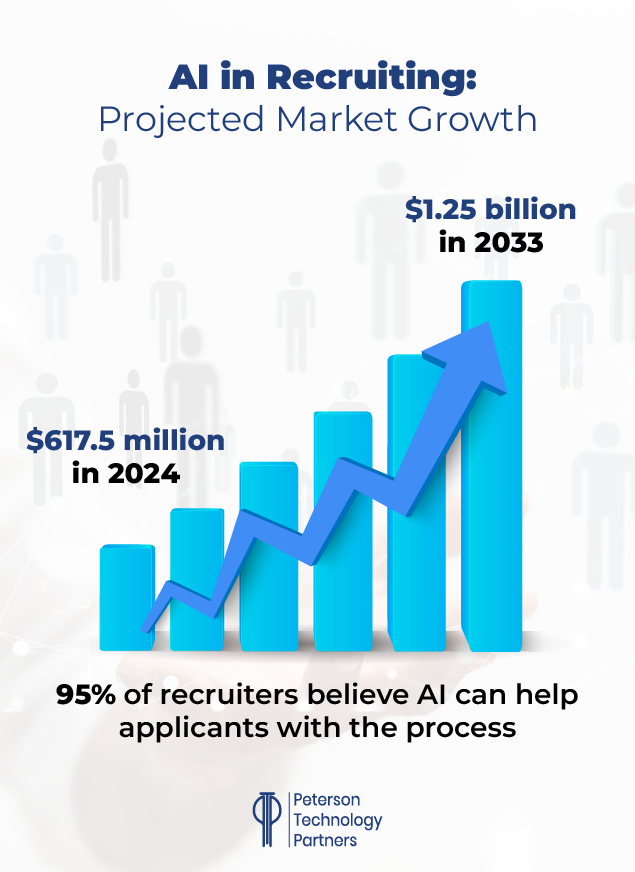
Challenges and Risks in AI Candidate Screening
While there are clear wins being achieved, there are also still challenges being worked through and ongoing risks for companies implementing automated hiring solutions.
First off, communication is critical to success. Among Gallup’s findings, despite 93% of CHROs acknowledging using AI, only 33% of employees indicated they are aware of it. And only 15% confirmed they’d heard a clearly communicated plan on AI integration from leadership.
Why does this matter? From the same findings, employees are found to be 4.7 more likely to feel comfortable using AI when they agree their organization has a strong plan in place.
The same holds true for job applicants.
While 79% of recruiters in Tidio’s surveys believe AI can handle the entire hiring process in the near term, 56% of candidates believe the final decision on hiring should always be done by a human being.
Regulations also make this an important area for clarity. From the GDPR to emerging (and varied) state regulations, automated decision-making is being highlighted for restrictions and documentation and must be well communicated.
A lack of transparency and understanding of the process works is troublesome when questions arise, but it also fuels ongoing fears that people can game automated systems by manipulating submitted data or even using techniques in interviews.
Then there’s the question of bias in AI hiring. While many organizations claim these solutions are actually reducing human biases, there are documented cases of selection issues that must be addressed in AI systems.
Fountain CEO Sean Behr, for example, tells Keith Ferrazzi for his piece in Forbes of their AI agent:
“I think it does a better job than humans. It does it faster and more effectively, and it does it in a bias-free way.”
But AI systems draw from human data sources, which means that by default they are likely to reflect historical hiring patterns and can suppress candidates outside this box.
Examples include applicants lowering birthdates on resumes and resubmitting with better results, of getting higher marks for certain hobby sports than others (baseball and basketball over softball), of getting well-graded while speaking nonsensical versions of languages, and more.
Efforts are being made to create and promote publicly available alarm systems for sniffing out algorithmic bias, such as the Conditional Demographic Disparity test (implemented by Amazon and IBM among others) which notifies which hiring decision criteria may have caused AI bias, giving users a chance to address these.
But the speed of development and fierceness of competition can race ahead of sufficient testing, leaving the burden on companies to ensure their hiring practices remain as transparent and fair as possible even as they implement AI solutions which can processes exponentially as many candidates as humans over the same time span.
PTP’s Ongoing Experience with Talent Acquisition AI
As tech recruiters and consultants with more than 27 years of experience, PTP has been developing and utilizing AI in safe and controlled ways for years.
From pre-screening automation to AI scheduling to initial contact, we’ve explored numerous ways of improving not just the efficiency, but also the quality and security of the process.
This recently included our own AI-led screenings for internship positions. The system scored candidates on communications, and sentiment analysis, as well as conducting entire technical screenings.
And while such a full range of automation is not likely to replace our Five-Point Recruiting process with its CIO-led screening, it does augment the process, improving the efficiency, quality, and even the extent of contact with candidates.
But as PTP’s Recruiting and Operations Manager Pooja Joshi says, it continues to be about finding the right combination:
“AI makes hiring faster and more efficient, but it’s human insight that ensures the right fit. The real magic happens when we blend both—bringing in not just speed, but the kind of talent that thrives and stays for the long run.”
Conclusion
Will AI systems soon be capable of conducting an entire hiring process, end-to-end?
How about finding openings even before they happen, proactively scouting out talent who may not even be looking, identifying needed skills and internal candidates for training and promotion? Of negotiating, onboarding, filling and submitting necessary forms, maintaining required documentation, and conducting advanced analysis and reporting?
It’s not a wild leap of the imagination to say yes. And all of this is either here already or likely coming sooner than many expect.
But the capacity to do is one thing, and the end quality, oversight, confidence, trust, and transparency in decision-making are still significant questions.
Keeping human judgement, oversight, and experience in the process will be essential not only for quality results but also for compliance, even as the benefits of AI-powered recruiting solutions only continue to grow.
There’s no doubt AI is going well past solving its initial need to search mountains of materials and help companies find the best possible fit. The only question is where it’s going next.
You can check out our previous AI Works entry on the healthcare industry here.
References
Hiring with AI doesn’t have to be so inhumane, World Economic Forum
AI Recruitment Statistics: What Is the Future of Hiring?, Tidio
Why Chipotle is turning to AI as it steps up its seasonal hiring to 20,000, Market Watch
AI Recruitment Market Size, Straits Research
How to Get Hired When AI Does the Screening, Harvard Business Review
The Amazing Ways How Unilever Uses Artificial Intelligence To Recruit & Train Thousands Of Employees, Bernard Marr & Co.
AI in the Workplace: Answering 3 Big Questions, Gallup Workplace
The AI Recruitment Takeover: Redefining Hiring In The Digital Age, Forbes
AI hiring tools may be filtering out the best job applicants, BBC
FAQs
Bottom line: Does AI really make hiring fairer, or does it reinforce existing biases?
Both are being trumpeted by various parties, and to a certain extent, both can be true, depending on the solution.
Yes, AI can make hiring fairer, if it’s trained and audited carefully. It can draw in more data for analysis and consider more criteria and from varying points of view. But this requires not only using sufficiently diverse training data, but also screening results, criteria, and the process for fairness and making necessary adjustments. And in the end, humans at this stage must remain in the loop.
What parts of the hiring process are now most commonly being performed by AI?
Writing and posting job descriptions, sourcing and matching candidates, and pre-screening are most widely done with AI assistance now. Increasingly, conversational AI is being used effectively for scheduling, to conduct initial interviews, and even complete stages of the technical interview process.
How do candidates feel about an AI-led hiring processes?
Surveyed job applicants prefer AI in the hiring process in the early stages than the so-called “black hole” experience, for the improved level of contact, feedback, scheduling, and capacity to get relevant information.
At the same time, communication on the use of AI is essential, and a majority of candidates regularly indicate they want final decisions made by human beings.

